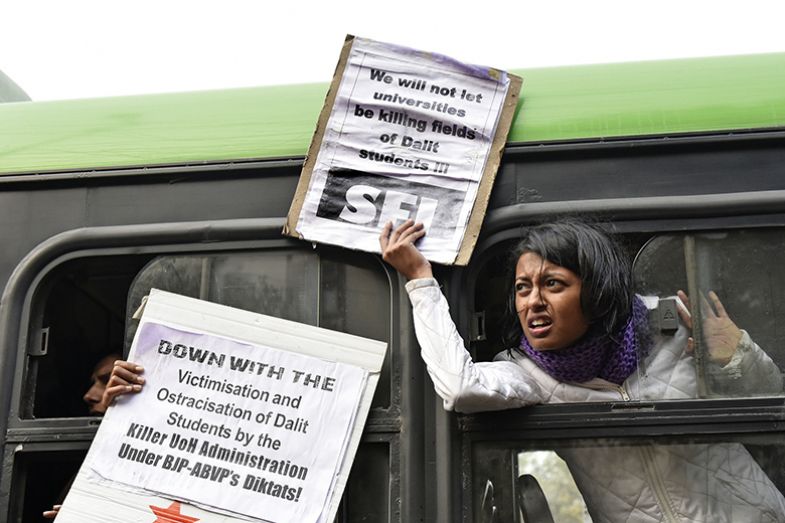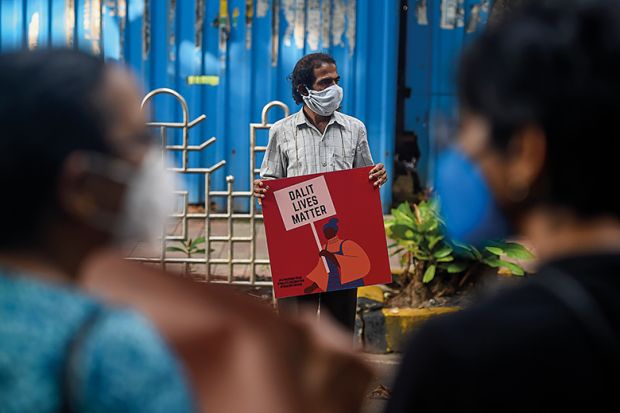Saraswati is the Hindu goddess of learning. In her four hands, she holds a book, a rosary, a pot and a musical instrument – the veena – but no weapons.
Can Saraswati kill?
The writer Kancha Ilaiah Shepherd recalls his mother’s terrifying words to the man who had come to their house asking her to send her children to school.
“Saraswathi teaches the children of Bapanollu and Komatollu,” she said, indicating upper-caste children, “but she becomes a devil when it comes to our children. She will not allow our children to read and write. She will kill them. That is how my elder son died.”
Shepherd identifies as a Sudra intellectual and activist – part of the lowest group in the Hindu caste order, traditionally excluded from education (which has been dominated by the upper castes, and notably the Brahmins: see box below).
The fear of a killer-Saraswati entered the young boy’s nightmares. The goddess would appear as a female ghost from village lore, “in a white sari and a white blouse, with untied hair”, and the young Shepherd would wake up in the middle of the night and shout, “Ghost…Ghost…School…School…”
For my own part, I grew up adoring Saraswati, with an aesthetic devotion that grew with my love for the arts and literature. The lore of the goddess of learning was deep in my family. When I was born, my grandmother wrote a poem where she called me, with a classic grandmotherly flourish of affection, “the godson of Saraswati”. Shepherd’s grandmother, on the other hand, was the source of the fear of Saraswati in his family.
I write this as India sits under the pall of the brutal rape and murder of a 19-year-old Dalit (“untouchable” in the caste system) woman in Hathras, a village in Uttar Pradesh. Yet the killer-Saraswati of Shepherd’s childhood nightmare also continues to haunt the corridors of India’s institutes of higher education.
“What does it mean,” Simple Rajrah writes in anguish, “to lose Dr Payal Tadvi, Rajini Krish, Rohith Vemula, Senthil Kumar, Madari Venkatesh, and Aniket Ambhore, among countless others, to institutional murder?” All of these were university students from oppressed castes who died by suicide. Most of them, as Rajrah – a researcher at the University of Oxford – points out, were first-generation learners, including so-called untouchables, whose very presence in premier institutes of higher education symbolised the defiant spirit of such communities in the face of endless cruelty, oppression and hurdles put in their way.
Although India has a system of reserved places for those from castes classified as historically disadvantaged, this is limited to publicly funded institutions (which often fail to meet the targets). Since the 1990s, as anthropologist Ajantha Subramanian points out, there has been an expansion of private engineering colleges, which have “become key sites of dominant caste technical science education”.

Many people assume that such abuses are confined to India.
“One time in a bar in Atlanta,” Sujata Gidla writes in her intimate family history, Ants Among Elephants: An Untouchable Family and the Making of Modern India, “I told a guy I was untouchable, and he said, ‘Oh, but you are so touchable.’”
Gidla identifies as a Dalit. When she arrived in the US, she thought that people would care about skin colour but not about birth status, and that she had left caste oppression behind.
Yet this is unduly optimistic. B.R. Ambedkar, the great Indian social and political reformer, once predicted that “if Hindus migrate to other regions of the earth, Indian caste would become a world problem”. And history is proving him right. There is clear evidence that the vast Indian diaspora has led to the globalisation of caste discrimination, notably to countries such as the US and UK, where there is a high concentration of people of Indian origin but where caste oppression has struggled for legal and social recognition.
The most recent high-profile legal accusation was in June, when California’s Department of Fair Employment and Housing charged Cisco Systems, accusing two senior managers (of upper-caste Indian background) of discriminating against a Dalit engineer.
“In many ways,” argues Shubranshu Mishra, a lecturer in politics and international relations at the University of Exeter, “this case bares open the proximity of upper-caste communities that aspire to whiteness and ally with white supremacy and thereby punctures the tendency to represent the South Asian diaspora as monolithic, homogenous and casteless.”
Mishra also cites the public consultation process initiated in the British House of Lords to make caste discrimination illegal in the UK, which led a reluctant government to amend the 2010 Equality Act to consider caste as “an aspect of race”. However, following a public consultation and under pressure from powerful Hindu lobbies (led by caste-privileged Hindus), the government in 2018 took the position that there was no need to provide “additional statutory protection in the Equality Act”, thereby deciding against enacting the amendment.
In the absence of clear legislation, caste-based violence is hard for law-enforcement agencies in Western societies to fully understand. We are also beginning to see a number of cases of caste discrimination at universities outside India.

Suraj Yengde, a senior fellow in Harvard University's Kennedy School and author of the 2019 book Caste Matters, spoke to Religion News Service, an American news portal, about his experience of being assaulted by fellow Indian students multiple times as a result of his caste identity when he was a graduate student at Birmingham City University. But the police “just couldn’t understand it”, he said. “If there had been legislation that said ‘you cannot exercise caste-based discrimination’, I would have gone and told them that this was basically a hate-filled crime.”
Similarly, a former engineering student in the Boston area also told Religion News Service the story of how he was excluded from shared housing plans by his college room-mates as soon as they found out about his “low” caste origin – although he only spoke on condition of anonymity, for fear of retribution.
A third case was revealed to WBGH News by Rajkumar Kamble, a chemical engineer in Houston, who worked with Ambedkar International, a Dalit human rights organisation. This concerned a student at the University of Alabama who was accepted on a doctoral science programme but later rejected by the lab director after he ran a “caste check” on the student’s background and found that he belonged to a “low” caste. (The student decided not to go to court. Given that caste is not a legal category of discrimination in the US either, it is unlikely that he would have achieved anything if he had.)
There is little doubt that we are going to see further instances of such international replication of caste structures. The number of Indian students studying abroad has vastly expanded in the 21st century (at least in the pre-pandemic era), rising from 66,713 in 2000 to 301,406 in 2016, according to data from the Unesco Institute of Statistics.
In December 2019, Brandeis University in Massachusetts set a crucial precedent when it became the first US university to add caste to its non-discrimination policy. As reported in Inside Higher Ed, 11 per cent of Brandeis students identified at the time as Asian, and 90 of the university’s 1,571 international students in 2018 were from India. The university, which was founded as a haven for Jewish students at a time of rampant antisemitism, is aware of examples of caste-based ostracism but not of any formal infraction such as the denial of a position. “We want to be sure,” the university’s chief diversity officer, Mark Brimhall-Vargas, told Religion News Service, “that we head that off before that ever would become a problem.” More than anything else, the institution has changed its discrimination policy as a preventive measure. Other universities may soon need to take similar steps.
“Across time and culture,” writes the American journalist Isabel Wilkerson, in Caste: The Lies That Divide Us, “the caste systems of three very different countries have stood out, each in their own way. The tragically accelerated, chilling and officially vanquished caste system of Nazi Germany. The lingering, millennia-long caste system of India. And the shape-shifting, unspoken, race-based caste pyramid in the US.”
Wilkerson argues that race and caste are neither identical nor mutually exclusive. “Caste is the bones, race the skin.” While race is more easily visible, in the skin, caste structures the scaffolding of society, holding groups in rigid spaces, revealing itself in subterranean behaviour patterns.
The affinities between the debate over Dalit lives in India and black lives in the US are both more pervasive and more complex than has been imagined so far. Discussions about diversity in Western universities – even those with significant Hindu populations – have seldom paid much attention to caste. They are going to have to start. This is partly a matter of preventing the specific kinds of campus-based discrimination I have described. But it is also a crucial element of a broader project, which has received fresh impetus from Black Lives Matter and campaigns to decolonise universities and their curricula, to create more pluralistic and inclusive institutions.
Saikat Majumdar is professor of English and creative writing at Ashoka University. Research input was provided by Harshita Tripathi.
The basics of the caste system
Ancient Hinduism developed the system of dividing society into a hierarchical order of castes, assigning different professional and social positions to different groups.
The system was periodically reimagined and deployed by various ruling elites, including the Muslims in medieval India and the British in the colonial period.
There are four primary castes: Brahmins (the priestly caste), Kshatriyas (the princely or warrior caste), the Vaishyas (the trading or business caste) and the Shudras (the labouring class).
Groups left out of the caste system included tribal and aboriginal peoples, and people considered impure or “untouchable”. These are the most acutely caste-oppressed peoples, who, in modern India, have asserted the identity of “Dalit” (literally meaning “trampled”) as part of a broad anti-caste movement.
Register to continue
Why register?
- Registration is free and only takes a moment
- Once registered, you can read 3 articles a month
- Sign up for our newsletter
Subscribe
Or subscribe for unlimited access to:
- Unlimited access to news, views, insights & reviews
- Digital editions
- Digital access to THE’s university and college rankings analysis
Already registered or a current subscriber? Login








